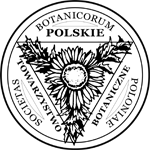Pollinator limitation affects low reproductive success in populations of nectarless orchid in the Biebrza National Park
Abstract
Keywords
Full Text:
PDFReferences
Turnbull LA, Crawley MJ, Rees M. Are plant populations seed-limited? A review of seed sowing experiments. Oikos. 2000;88:225–238. https://doi.org/10.1034/j.1600-0706.2000.880201.x
Tremblay RL, Ackerman JD, Zimmerman JK, Calvo RN. Variation in sexual reproduction in orchids and its evolutionary consequences: a spasmodic journey to diversification. Bot J Linn Soc. 2005;84:1–54. https://doi.org/10.1111/j.1095-8312.2004.00400.x
Jacquemyn H, Brys R, Hermy M, Willems JH. Long-term dynamics and population viability in one of the last populations of the endangered Spiranthes spiralis (Orchidaceae) in the Netherlands. Biol Conserv. 2007;134:14–21. https://doi.org/10.1016/j.biocon.2006.07.016
Ackerman JD, Montalvo AM. Short- and long-term limitations to fruit production in a tropical orchid. Ecology. 1990;71:263–272. https://doi.org/10.2307/1940265
Johnson SD. Batesian mimicry in the non-rewarding orchid Disa pulchra, and its consequences for pollinator behaviour. Biol J Linn Soc. 2000;71:119–132. https://doi.org/10.1111/j.1095-8312.2000.tb01246.x
Neiland MRM, Wilcock CC. Fruit set, nectar reward, and rarity in the Orchidaceae. Am J Bot. 1998;85:1657–1671. https://doi.org/10.2307/2446499
Cozzolino S, Widmer A. Orchid diversity: an evolutionary consequence of deception? Trends Ecol Evol. 2005;20:487–494. https://doi.org/10.1016/j.tree.2005.06.004
O’Connell LM, Johnston MO. Male and female pollination success in a deceptive orchid. A selected study. Ecology. 1998;79:1246–1260. https://doi.org/10.1890/0012-9658(1998)079[1246:MAFPSI]2.0.CO;2
Tamm CO. Survival and flowering of some perennial herbs. II. The behavior of some orchids on permanent plots. Oikos. 1972;23:23–28. https://doi.org/10.2307/3543923
Jersáková J, Kindlmann P. Patterns of pollinator-generated fruit set in Orchis morio (Orchidaceae). Folia Geobot. 1998;33:377–390. https://doi.org/10.1007/BF02803641
Kull T. Fruit set and recruitment in populations of Cypripedium calceolus L. in Estonia. Bot J Linn Soc. 1998;126:27–38. https://doi.org/10.1111/j.1095-8339.1998.tb02513.x
Brzosko E. Dynamics of island populations of Cypripedium calceolus in the Biebrza River valley (north-east Poland). Bot J Linn Soc. 2002;139:67–77. https://doi.org/10.1046/j.1095-8339.2002.00049.x
Brzosko E. The dynamics of island populations of Platanthera bifolia in the Biebrza National Park (NE Poland). Ann Bot Fenn. 2003;40:243–253.
Vandewoestijne S, Róis AS, Caperta A, Baguette M, Tyteca D. Effects of individual and population parameters on reproductive success in three sexually deceptive orchid species. Plant Biol. 2009;11:454–463. https://doi.org/10.1111/j.1438-8677.2008.00125.x
Sun HQ, Alexandersson R, Ge S. Positive effects of flower abundance and synchronous flowering on pollination success, and pollinia dispersal in rewardless Changnienia amoena (Orchidaceae). Biol J Linn Soc. 2010;99:477–488. https://doi.org/10.1111/j.1095-8312.2009.01369.x
Fritz A-L, Nilsson LA. How pollinator-mediated mating varies with population size in plants. Oecologia. 1994;100:451–462. https://doi.org/10.1007/bf00317867
Potts SG, Biesmeijer JC, Kremen C, Neumann P, Schweiger O, Kunin WE. Global pollinator declines: trends, impacts and drivers. Trends Ecol Evol. 2010;25:345–353. https://doi.org/10.1016/j.tree.2010.01.007
González-Varo JP, Biesmeijer JC, Bommarco R, Potts SG, Schweiger O, Smith HG, et al. Combined effects of global change pressures on animal-mediated pollination. Trends Ecol Evol. 2013;28:524–530. https://doi.org/10.1016/j.tree.2013.05.008
Vakhrameeva MG, Latarenko IV, Varlygina TI, Torosyan GK, Zagulski MN. Orchids of Russia and adjacent countries (within the borders of the former USSR). Ruggell: A.R.G. Gantner; 2008.
Kull T. Cypripedium calceolus. J Ecol. 1999;87:913–924. https://doi.org/10.1046/j.1365-2745.1999.00407.x
Cribb P. The genus Cypripedium. Portland, OR: Timber Press; 1997.
Brzosko E, Werpachowski C. Island populations of Cypripedium calceolus. In: Falińska K. Plant population biology and vegetation processes. Cracow: W. Szafer Institute of Botany, Polish Academy of Sciences; 1998. p. 111–114.
Brzosko E, Wróblewska A, Ratkiewicz M. Spatial genetic structure and clonal diversity of island populations of lady’s slipper (Cypripedium calceolus) from the Biebrza National Park (northeast Poland). Mol Ecol. 2002;11:2499–2509. https://doi.org/10.1046/j.1365-294X.2002.01630.x
Nilsson LA. Anthecological studies on the lady’s slipper Cypripedium calceolus (Orchidaceae). Botaniska Notiser. 1979;132:329–347.
Bänziger H, Sun H, You YB. Pollination of wild lady slipper orchids Cypripedium yunnanense and C. flavum (Orchidaceae) in south-west China: why are there no hybrids? Bot J Linn Soc. 2008;156:51–64. https://doi.org/10.1111/j.1095-8339.2007.00755.x
Zarzycki K, Szeląg Z. editors. The red list of vascular plants in Poland. In: Mirek Z, Zarzycki K, Wojewoda W, Szeląg Z. Red list of plants and fungi in Poland. Cracow: W. Szafer Institute of Botany, Polish Academy of Sciences; 2006. p. 9–20.
Kaźmierczakowa R, Zarzycki K, Mirek Z, editors. Polska czerwona księga roślin: paprotniki i rośliny kwiatowe. Kraków: Instytut Ochrony Przyrody, Polska Akademia Nauk; 2014.
Terschuren J. Action plan for Cypripedium calceolus in Europe. Strasbourg: Council of Europe; 1999. (Nature and Environment; vol 100).
Piękoś-Mirkowa H, Mirek Z. Flora Polski. Atlas roślin chronionych. Warszawa: Multico Oficyna Wydawnicza; 2003.
Brzosko E, Wróblewska A. Low allozymic variation in two island populations of Listera ovata (Orchidaceae) from NE Poland. Ann Bot Fenn. 2003;40:309–315.
ESRI. ArcGIS desktop: release 10. Redlands, CA: Environmental Systems Research Institute; 2011.
VassarStats: Website for Statistical Computation [Internet]. 2017 [cited 2017 Feb 22]. Available from: http://vassarstats.net
Pedersen HÆ, Hanne N. Rasmussen HN, Fay MF. Genetic diversity, compatibility patterns and seed quality in isolated populations of Cypripedium calceolus (Orchidaceae). Conserv Genet. 2012;13:89–98. https://doi.org/10.1007/s10592-011-0267-0
Barrett SCH, Helenurm K. The reproductive biology of boreal forest herbs. I. Breeding systems and pollination. Can J Bot. 1987;65:2036–2046. https://doi.org/10.1139/b87-278
Falb DL, Leopold DJ. Population dynamics of Cypripedium candidum Muhl. Ex Willd., small white ladyslipper, in a western New York fen. Natural Areas Journal. 1993;13:76–86.
Primack R, Stacy E. Cost of reproduction in pink lady’s slipper orchid (Cypripedium acaule, Orchidaceae) an eleven-year experimental study of three populations. Am J Bot. 1998;85:1672–1679. https://doi.org/10.2307/2446500
Ramsay MM, Stewart J. Re-establishment of the lady’s slipper orchid (Cypripedium calceolus L.) in Britain. Bot J Linn Soc. 1998;126:173–181. https://doi.org/10.1111/j.1095-8339.1998.tb02524.x
Gill DE. Fruiting failure, pollinator inefficiency, and speciation in orchids. In: Otte D, Endler JA, editors. Speciation and its consequences. Sunderland, MA: Sinauer; 1989. p. 458–481.
Catling PM, Crever G. Pollination of the small white lady’s slipper (Cypripedum candidum) in Lampton County, southern Ontario. Canadian Field-Naturalist. 1980;94:435–438.
Lammi A, Kuitunen M. Deceptive pollination of Dactylorhiza incarnata: an experimental test of the magnet species hypothesis. Oecologia. 1995;101:500–503. https://doi.org/10.1007/BF00329430
Ågren J. Population size, pollinator limitation, and seed set in the self-incompatible herb Lythrum salicaria. Ecology. 1996;77:1779–1790. https://doi.org/10.2307/2265783
Kindlmann P, Jersáková J. Effect of floral display on reproductive success in terrestrial orchids. Folia Geobot. 2006;41:47–60. https://doi.org/10.1007/BF02805261
Brys R, Jacquemyn H, Hermy M. Pollination efficiency and reproductive patterns in relation to local plant density, population size, and floral display in the rewarding Listera ovata (Orchidaceae). Bot J Linn Soc. 2008;157:713–721. https://doi.org/10.1111/j.1095-8339.2008.00830.x
Dauber J, Biesmeijer JC, Gabriel D, Kunin WE, Lamborn E, Meyer B, et al. Effects of patch size and density on flower visitation and seed set of wild plants: a pan-European approach. J Ecol. 2010;98:188–196. https://doi.org/10.1111/j.1365-2745.2009.01590.x
Sun M, Gross K, Schiestl FP. Floral adaptation to local pollinator guilds in a terrestrial orchid. Ann Bot. 2014;113:289–300. https://doi.org/10.1093/aob/mct219
Internicola AI, Juillet N, Smithson A, Gigord LDB. Experimental investigation of the effect of spatial aggregation on reproductive success in a rewardless orchid. Oecologia. 2006;150:435–441. https://doi.org/10.1007/s00442-006-0530-0
Steven JC, Rooney TP, Boyle OD, Waller DM. Density-dependent pollinator visitation and self-incompatibility in upper Great Lakes populations of Trillium grandiflorum. J Torrey Bot Soc. 2003;130:23–29. https://doi.org/10.2307/3557522
Goulson D. Why do pollinators visit proportionally fewer flowers in large patches? Oikos. 2000;91:485–492. https://doi.org/10.1034/j.1600-0706.2000.910309.x
DOI: https://doi.org/10.5586/aa.1706
|
|
|






